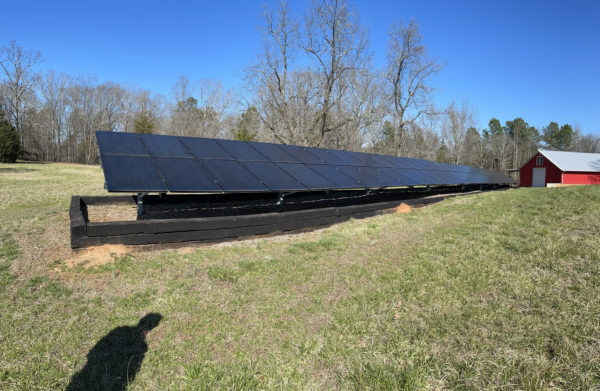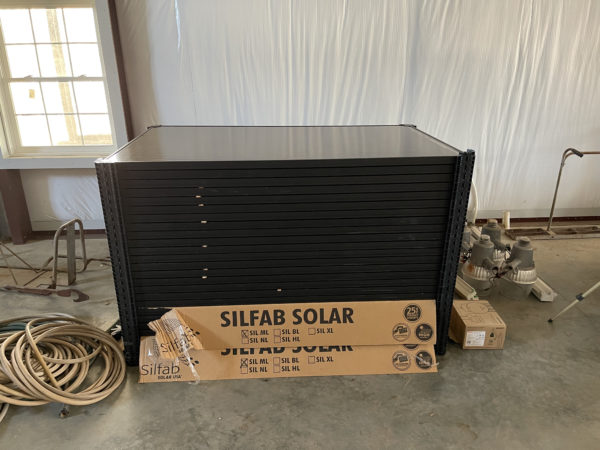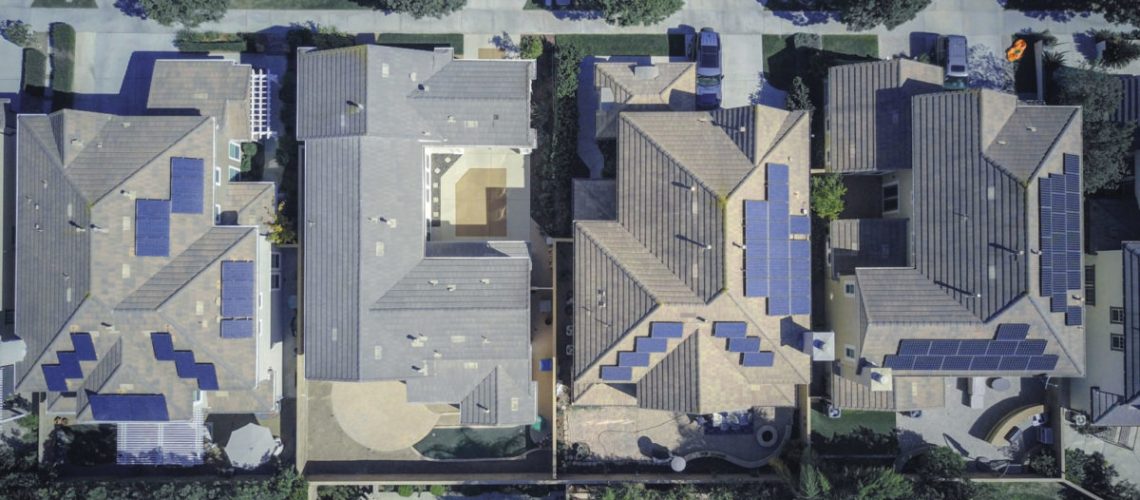Passing through Hartwell, Georgia, one would find it hard to envision the town as the center of the rapidly-evolving transition to renewable energy, at least for the time being. In many ways, Hartwell presents the classic aesthetic of the American South: rolling fields dotted with quaint ranch houses and farmsteads giving way to forests of tall pines, seemingly standing in formation, and series of creeks, brooks, and ponds, all of which attract the town’s non-human residents, namely great blue heron and whitetail deer.
That is, until you pass down another unassuming country road, down which one of the area’s dime-a-dozen big, red barns is flanked by something more familiar to clean energy veterans: a 20kW ground-mounted solar system.
If the system serves as a sign of what’s to come in the future of power generation and consumption for Georgia and the world at large, then it’s especially fitting that it belongs to longtime Hartwell resident and author of the groundbreaking book, Freeing Energy, Bill Nussey.
Published in December 2021, Freeing Energy explores the concept of our energy grid inevitably evolving in the same way that computers and the internet did – with local solar and battery storage replacing large-scale, centralized power plants as the most reliable and economical option, much in the same way personal computers and the invention of the cloud eclipsed existing mainframe technology. Using another metaphor, from the spoke-and-wheel to the network.
Going local
It’s a concept Nussey calls “local energy,” and pv magazine had the opportunity to meet Nussey at his Hartwell farm to discuss what it means, and how the concept is already changing the world. To understand the potential of local energy, you first need to understand what Nussey means with the term and how it differs from other oft-used terms in the small-scale renewables space, like residential solar, distributed energy resources (DERs), or residential batteries. For Nussey, half the battle of presenting his vision for the world’s energy future was deciding what to call it, though he’ll be the first to tell you that others had coined the term before him.
“All the words that we usually use: DERs, behind the meter, these words are all used by groups of people that have a vested interest in the existing system,” explained Nussey. “And so it’s always in the context of this 100-year-old industry that’s outdated and needs to change. I wanted to create a new phrase that not only represented the technical dimension that it’s generated locally, but had the emotional draw. This is also about human beings. This is about families and communities.”
The main tenants behind local energy are relatively simple. Our current energy system, globally, but especially so in the United States, is outdated. Few argue this point. It was developed during a time when the idea of being able to power one’s home was novel, and when building large, centralized power stations was the most cost-effective and reliable way to deliver that power.

And while these initial arguments may no longer hold, the system remains in place, largely unchanged. All of the issues and arguments that bog down our efforts to rapidly switch to a cleaner energy supply, be they suboptimal regulatory practices, long interconnection delays, or utilities’ tooth-and-nail defense of the fossil fuel generating stations that made them profitable, all exist because of the existing power and energy framework.
Tech meets electrons
It’s an idea that Bill calls “Big Grid” in the same way that one may lump Google, Meta, and Amazon together as “Big Tech.” In Freeing Energy, the Big Grid serves as the energy transition’s antagonist, rather than the usual culprits of utilities or the regulators that oversee them. As Nussey sees it, while these actors may make contributions that stifle our transition to clean energy, their decisions are largely influenced by the need to operate in the system that they were made for: sustaining the Big Grid.
“It’s easy to kick the shins of the utility industry.” Nussey says. “Vilifying them as individual companies, or even in the industry is weak. It’s a crutch, but you always have to have a villain if you’re going to have people engaged. And so Big Grid became the villain, which really represents the status quo rather than any particular company.”
Nussey lays out that the disestablishment of this status quo is the key to transitioning to a grid powered by clean, local energy. However, the act of actually looking at a system as ingrained as the large-scale electrical grid, the regulated monopolies that exist to serve and use it, the regulators that oversee these monopolies, and all the other dozens of actors in the space is overwhelming, to say the least.
The scope of this issue has led many, even those in the clean energy space, to question skeptically if an energy transition of any sort, let alone one rapid enough to mitigate the adversity of climate change, is even possible. To Bill Nussey, there is no question. The transition is inevitable.
Nussey outlines that large-scale change of incumbent entities comes about one of two ways: either powerfuel actors and decision-makers recognize an issue and take charge, or the public supports an issue fererenty and en masse, to the point where it can’t be ignored and action must be taken.
It’s the second avenue that Nussey sees as the mechanism local energy will use to dethrone Big Grid. And while emotions and action may not have reached the fever pitch necessary to start making tangible change quickly, support for renewables, especially small scale, consumer-sided solutions, is only growing nationally.
Popular switch
Opinion polls conducted both nationally and at the state level show overwhelming bipartisan support for the clean energy transition.

Embold Research recently released the results of a survey given to 1360 adults living in Pennsylvania, including the southwest portion of the state, a fossil-fuel hotbed where that industry has provided jobs for decades. The survey results showed that solar energy has strong support across political, racial, gender, and regional lines, with 81% of survey respondents indicating “support” or “strong support” for rooftop solar on homes, making it more popular than coal, nuclear energy, and methane gas. 65% of respondents shared that they would like to see Pennsylvania generate more solar, citing reasons ranging from reduced air pollution to energy bill savings. Not a single demographic group or region expressed a desire for decreased solar production.
One of the core tenets of Freeing Energy is understanding that, unlike coal or natural gas, solar energy is a technology, not a fuel, meaning that it is more subject to rapid innovations and improvements, as well as dramatic cost reductions as production volume increases – also known as Wright’s Law, which open up supply chains and lower overall costs.
Understanding that solar should be thought of as a technology influencing energy in the same way that microprocessors and cloud computing are technologies that influenced the data and communications industries, parallels can be drawn from how disrupting other seemingly-immovable regulated monopolies is possible and how that disruption birthed some of the innovations that modern life is founded upon.
“AT&T fought to maintain a monopoly on long distance phone calls, and they lost,” explained Nussey, referencing the landmark 1982 decision in United States v. AT&T. “The inevitability was that there were better solutions available. AT&T recognized them, but they couldn’t adopt them nearly as fast and didn’t want to anyway. Thankfully, the courts and the government won, because there’d be no internet if AT&T held their monopoly; there would be no mobile phones. These innovations were not always inevitable, they came to be because that market became deregulated and innovators could enter the market.”
In disrupting the Big Grid, it’s not Nussey’s goal to entirely dismantle monopoly utilities and put thousands out of work. His vision still has a place for utilities, just in a different, and potentially more profitable, role. In a reality where tens of millions of homes and small communities can act as their own microgrids, managing all of these generation assets, their production, consumption, battery charging and discharging, as well as critical grid operations, like frequency regulation, will still be an immensely important industry, one that utilities are already built for.
“The problem is that you have to have all the capacity in your house for all possible situations in your house, as do your neighbors,” Nussey says. “It’s super cheap if you just pool it with your neighbors, right, and there is no more natural group to help facilitate that pooling than the utilities.”
In a sense, instead of working as suppliers, utilities would begin to work as aggregators, marketplace management arms, and a marketplace platform.
“They go from being Walmart to being eBay,” says Nussey, always quick with an analogy. “You can’t move into the future by saying ‘I don’t want utilities,’ you can’t make utilities go away. Society as we know it would collapse … There’s good reasons why utilities are separate corporations. They can access an amount of capital that nobody wants to be taxed to pay.”
This capital to which utilities have access could also be used to help bring local energy to those who aren’t able to afford solar and storage systems for themselves, or those whose living spaces can’t accommodate the installations. However, many times the exact opposite rhetoric is used to downplay the potential of local energy, using the age-old argument that those using their own energy are raising the cost of service to those who don’t, usually in an economically disproportionate fashion.
“You hear utilities saying, ‘Holy cow, if the wealthy people put solar on their roof, that’s going to raise the cost of the grid for poor people.’” Nussey explained. “If you have an asset-driven business, including the grid, you are shifting costs … If you live in a poorer area of an inner city, the cost of wiring each apartment is very small, right? But you’re paying the same rate as we are out here in a rural part. Low-income people in a dense city are subsidizing rural people who are paying the same rate, but they have 1000s of miles of wires connecting them to the grid, whereas hundreds of feet would be enough to connect the inner-city families.”
Freeing Energy dives into the hypocrisy of the cost-shift arguments as it pertains to residential solar, as well as the issues of energy equity and the burden of solar’s soft costs much deeper than is possible in a single article.
The story of local energy does not end with Freeing Energy, however and it is Nussey’s hope that his book will be able to play a part in the energy transition that he sees as inevitable; one which will provide access to cheap electricity and resiliency to everyone, without relying on the sluggish reluctance of Big Grid.



